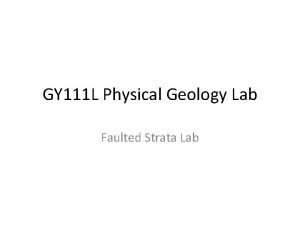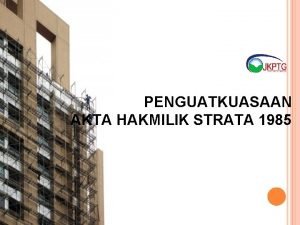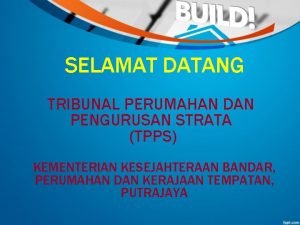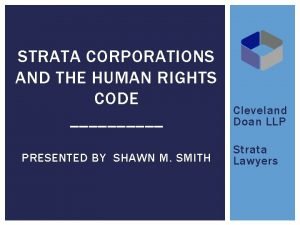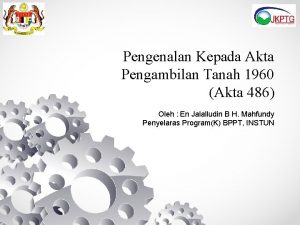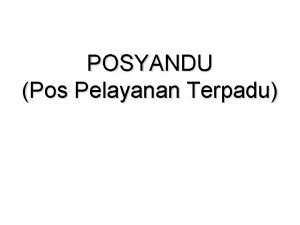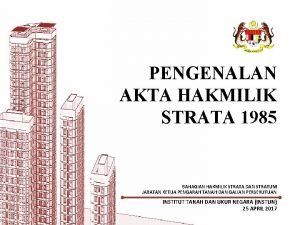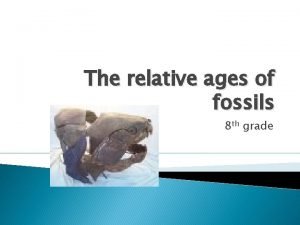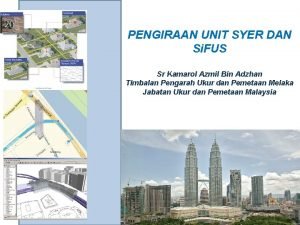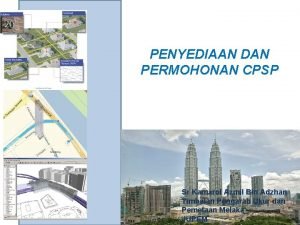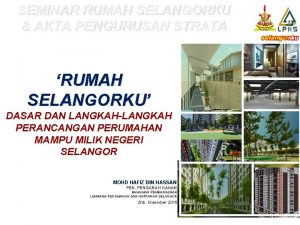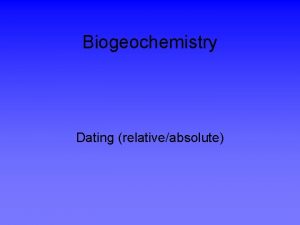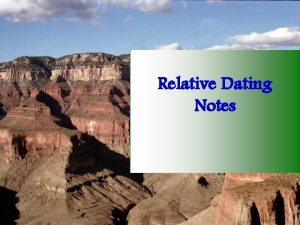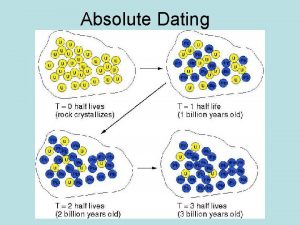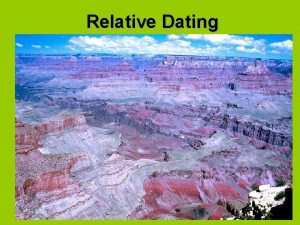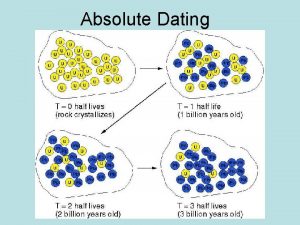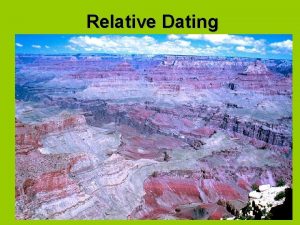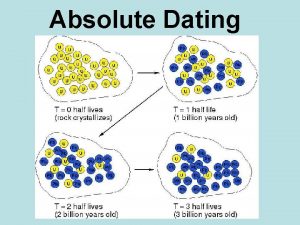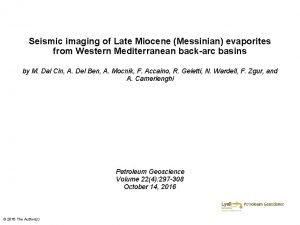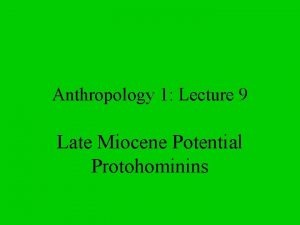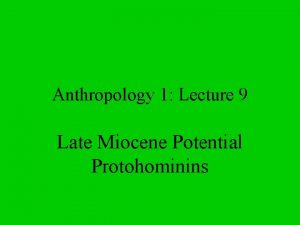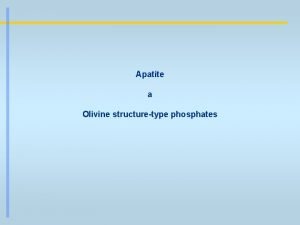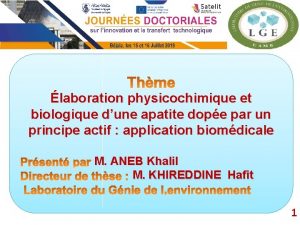Apatite Fissiontrack Dating from the Late Miocene Strata
























- Slides: 24

Apatite Fission-track Dating from the Late Miocene Strata (Lilungshan Formation) in the Hengchun Peninsula, Southern Taiwan: Implications for Exhumation History 以晚中新世里龍山層磷灰石核飛跡定年探討台灣 南部恆春半島剝蝕抬升歷史 Student: 杲紹伊 Shao-Yi Gao Advisor: 陳文山 Wen-Shan Chen Department of Geosciences, National Taiwan University

1. Introduction 2. Methodology 3. Result & Discussion 4. Conclusion n Motivative • This study aims to investigate thermal history regarding the Lilungshan Formation in the Hengchun Peninsula with low-temperature thermalchronometry (AFT). • Whether the AFT ages in our research region have been post-depositional reset or not? 1. Post-depositional reset Basin evolution and exhumation history. 2. Without post-depositional reset Source provenance analysis and exhumation history of source area (Yuli belt). 2

1. Introduction 2. Methodology 3. Result & Discussion 4. Conclusion n Geological background n In late Miocene, the Hengchun Peninsula was an accretionary prism. n Lilungshan Formation (1)NN 11, 5. 6~8. 3 Ma (Nannofossil) (2)Upper fan deposits in shelf environments (3)Paleocurrent: from the NW to the SE. n Outcrops of Yuli belt were low-grade metamorphic rocks in the late Miocene. 陳文山 (2005)

1. Introduction 2. Methodology 3. Result & Discussion 4. Conclusion n Literature review • The highlight samples are argillites from the Shihmen Formation. • AFT age has been totally reset at the metamorphic temperature of argillite. • Apatite FT closure temperature: 90 -135°C Zircon FT closure temperature: 200 -250°C Argillite metamorphic temperature: 200 -250°C • Zircon FT ages from Liu et al. (2001): gray • Zircon FT ages from Willett et al. (2003): gray, underline • Apatite FT ages from Willett et al. (2003): black Apatite ages are pooled ages (in Ma). 4

1. Introduction 2. Methodology 3. Result & Discussion 4. Conclusion n Literature review The Lichi Mélange: A collision mélange formation along early arcward backthrusts during forearc basin closure, Taiwan arc-continent collision (Huang et al. , 2008) • Deep-sea-fan sandstones. • The frequency of the Mesozoic peak is as high as the Neogene peak, similar to that found in the whitish sandstone blocks of the Lichi Mélange. 5 ZFT

1. Introduction 2. Methodology 3. Result & Discussion n Literature review Testing inferences from palaeocurrents: application of zircon double-dating to Miocene sediments from the Hengchun Peninsula, Taiwan (Kirstein et al. , 2010) • The sandstones were medium to coarse grained with rounded to sub-angular mafic clasts. ZFT 4. Conclusion

1. Introduction 2. Methodology n Thermochronometry 3. Result & Discussion 4. Conclusion n Closure Temperature The accumulation of the radiogenic daughter product below a certain temperature range, but the radiogenic products are lost and the system is open above the temperature. n Cooling age Bernet (2018)

1. Introduction 2. Methodology 3. Result & Discussion 4. Conclusion n Track-formation processes Spontaneous fission is occurs with heavy nuclides of atomic number Z≧ 90 and atomic mass A≧ 230. Such as 238 U (dominant), 235 U, 232 Th. The three stages of track formation according to the “ion explosion spike” theory of Fleischer, Price, and Walker. (A) Ionization (B) Coulomb repulsion (C) Elastically straining. (After Fleischer et al. , 1975)

1. Introduction 2. Methodology 3. Result & Discussion 4. Conclusion n Fading of fission tracks n Annealing means fission tracks fading due to the certain temperature higher than closure temperature. n Total reset age record has been cleared 9

1. Introduction 2. Methodology 3. Result & Discussion 4. Conclusion n Preparation strategy (1) Mounting, (2) Polishing, (3) Etching, (4) Irradiate, (5) Counting. *Using the External Detector Method (EDM) 10

1. Introduction 2. Methodology 3. Result & Discussion n Fission-track age equation n ζ-calibration method is a first-order reaction just like decay equation. Hurford and Green (1982, 1983) The decay equation is shown in the following: 4. Conclusion

1. Introduction 2. Methodology 3. Result & Discussion n Age distribution identify single- or multi-peak ρs 1 ρs 2 ρi 2 ρ i 1 *Standard error of passion distribution ρs 1/ρi 1 t 1 ρs 2/ρi 2 t 2 n Pooled age is used in low-uranium or young grains such as apatite. Ρs(total) Ρi(total) =ρs 1+ρs 2+…+ρsn =ρi 1+ρi 2+…+ρin ρsn/ρin T 4. Conclusion tn

1. Introduction 2. Methodology 3. Result & Discussion 4. Conclusion n Geological interpretation of FT age Deposition time Beginning of uplift After Wagner (1972) curve A: fast cooling curve B: slow cooling curve C 1: complex cooling with mix age curve C 2: complex cooling with total reset age. Cella, M. A. B. (2009) Modified from Crowley et al. 1989 13

1. Introduction 2. Methodology 3. Result & Discussion 4. Conclusion n Detrital apatite fission-track(AFT) analysis on sandstones: • Exhumation signal • Source provenance analysis • Basin evolution n Detrital AFT analysis on pebbles: • Cooling rate of source strata • Basin evolution n Lag time: The difference between the apparent cooling age and the time of deposition. Bernet (2018)

1. Introduction Conglomerate Sandstone 2. Methodology 3. Result & Discussion 4. Conclusion • When the pχ2 >5, the FT age is more like single-peak.

1. Introduction 3. Result & Discussion 2. Methodology 20180129_02 (Conglomerate) 20180129_23 (Sandstone) Age components(Ma) first peak second peak 2. 8 (100%) - Age components(Ma) first peak second peak 2. 5 (87. 4%) 9. 6 (12. 6%) • Is the peak caused by chlorinerich apatite in sandstone? • Can this be used to constraint the burial temperature? 4. Conclusion

1. Introduction 2. Methodology n Compositional effects 3. Result & Discussion 4. Conclusion Transition from hexagonal to monoclinic symmetry in the most chlorine-rich apatite High-chlorine grains resist annealing and thus record an older age than fluorine-rich grains. • Fluorine-rich apatites (such as Durango) typically show complete annealing of natural geological samples at temperatures of 90 -100°C, chlorine-rich samples are characterized by an increase of the total annealing temperature to around 110 -150°C Gleadow (2002); Green et al. (1985)

1. Introduction 2. Methodology 3. Result & Discussion 4. Conclusion • Apparent cooling age: 3. 2± 0. 2 Ma n Negative Lag Time • *Time of deposition: 6~7 Ma (NN 11, 5. 6~8. 3 Ma) represents post-depositional annealing • Lag time between -4 to -2. 6 Ma due to burial (Curve C 2). Deposition time curve A: fast cooling curve B: slow cooling curve C 1: complex cooling with mix age curve C 2: complex cooling with total reset age. Cooling time After Wagner

1. Introduction 2. Methodology 3. Result & Discussion n Discussion - Depth versus AFT age 4. Conclusion 1200 1000 Thickness(m) 800 600 400 200 0 2, 0 3, 0 4, 0 AFT age (Ma) 5, 0

1. Introduction 2. Methodology 3. Result & Discussion n Discussion - Depth versus AFT age Closure temperature Fission-Track-Thermochronology-and-its-Application-to-Geology (Ch 16) 4. Conclusion

1. Introduction 2. Methodology 3. Result & Discussion 4. Conclusion n Discussion - Depth versus AFT age 1200 Thickness: 1077 m Mean AFT age: 3. 2 Ma Exhumation rate of the basin: 1. 2~1. 3 km/m. y. Time interval: 0. 8 – 0. 9 m. y. (theoretical value) (1) The age distribution is within the error bar. (2) Almost all the strata were above the depth of AFT 800 Thickness(m) There was no correlation between depth and AFT age. 1000 600 400 closure temperature at the same time. 3 million years ago, the Lilungshan Formation was an inclined stratum, which attitude was similar to today’s. 200 0 2, 0 3, 0 4, 0 AFT age (Ma) 5, 0

1. Introduction 2. Methodology n Paleo-burial depth 3. Result & Discussion 4. Conclusion n Exhumation rate • Exhumation rate of the basin = Paleo-burial depth/ AFT age = 1. 2~1. 3 mm/yr.

1. Introduction 2. Methodology n Exhumation history of the basin 3. Result & Discussion 4. Conclusion

1. Introduction 2. Methodology 3. Result & Discussion 4. Conclusion 1. AFT ages of the Lilungshan Formation have been totally reset due to paleo-burial. 2. Uplift of the Hengchun Peninsula was since 3. 2± 0. 2 Ma. 3. Cooling rate of the basin: 35. 3~40°C/Ma. (assumed geothermal gradient was 30°C/km) 4. The paleo-burial depth of the Lilungshan Formation is about 4~5 km. 5. Exhumation rate of the basin: 1. 2~1. 3 mm/yr.
 Eocene oligocene miocene pliocene
Eocene oligocene miocene pliocene Dating serves several important functions that include
Dating serves several important functions that include Geology block diagram
Geology block diagram Contoh kertas siasatan polis
Contoh kertas siasatan polis Fungsi ttpr
Fungsi ttpr Akta pengurusan strata 2013
Akta pengurusan strata 2013 Strata plan vr 1097
Strata plan vr 1097 Warta seksyen 8
Warta seksyen 8 Strata hadoop
Strata hadoop Strata posyandu
Strata posyandu Assumption of liability form for strata
Assumption of liability form for strata Cluster random sampling vs stratified
Cluster random sampling vs stratified Strata building bond
Strata building bond Akta hak milik strata 1985
Akta hak milik strata 1985 Strata are mostly found brainpop quizlet
Strata are mostly found brainpop quizlet Unit syer
Unit syer Jenis kompetensi berdasarkan strata kompetensi
Jenis kompetensi berdasarkan strata kompetensi Cpsp strata
Cpsp strata Jenis rumah selangorku
Jenis rumah selangorku Jezus na pustyni idź precz szatanie
Jezus na pustyni idź precz szatanie Ukm strata pertama
Ukm strata pertama Thế nào là mạng điện lắp đặt kiểu nổi
Thế nào là mạng điện lắp đặt kiểu nổi Hình ảnh bộ gõ cơ thể búng tay
Hình ảnh bộ gõ cơ thể búng tay Khi nào hổ mẹ dạy hổ con săn mồi
Khi nào hổ mẹ dạy hổ con săn mồi Dạng đột biến một nhiễm là
Dạng đột biến một nhiễm là


